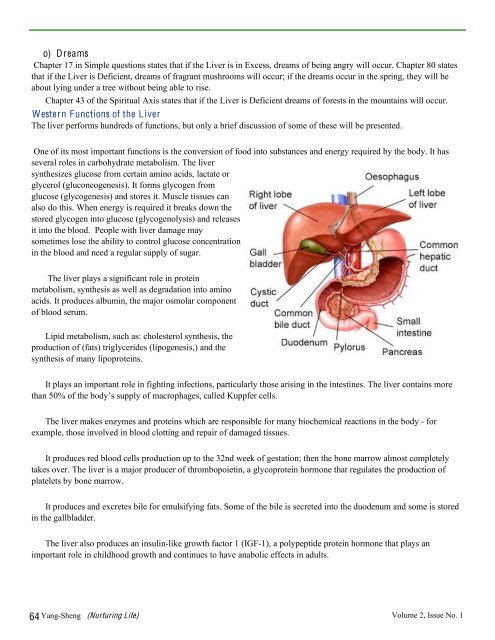Download PDF - Yang-Sheng
Download PDF - Yang-Sheng
Download PDF - Yang-Sheng
Create successful ePaper yourself
Turn your PDF publications into a flip-book with our unique Google optimized e-Paper software.
o) Dreams<br />
Chapter 17 in Simple questions states that if the Liver is in Excess, dreams of being angry will occur. Chapter 80 states<br />
that if the Liver is Deficient, dreams of fragrant mushrooms will occur; if the dreams occur in the spring, they will be<br />
about lying under a tree without being able to rise.<br />
Chapter 43 of the Spiritual Axis states that if the Liver is Deficient dreams of forests in the mountains will occur.<br />
Western Functions of the Liver<br />
The liver performs hundreds of functions, but only a brief discussion of some of these will be presented.<br />
One of its most important functions is the conversion of food into substances and energy required by the body. It has<br />
several roles in carbohydrate metabolism. The liver<br />
synthesizes glucose from certain amino acids, lactate or<br />
glycerol (gluconeogenesis). It forms glycogen from<br />
glucose (glycogenesis) and stores it. Muscle tissues can<br />
also do this. When energy is required it breaks down the<br />
stored glycogen into glucose (glycogenolysis) and releases<br />
it into the blood. People with liver damage may<br />
sometimes lose the ability to control glucose concentration<br />
in the blood and need a regular supply of sugar.<br />
The liver plays a significant role in protein<br />
metabolism, synthesis as well as degradation into amino<br />
acids. It produces albumin, the major osmolar component<br />
of blood serum.<br />
Lipid metabolism, such as: cholesterol synthesis, the<br />
production of (fats) triglycerides (lipogenesis,) and the<br />
synthesis of many lipoproteins.<br />
It plays an important role in fighting infections, particularly those arising in the intestines. The liver contains more<br />
than 50% of the body’s supply of macrophages, called Kuppfer cells.<br />
The liver makes enzymes and proteins which are responsible for many biochemical reactions in the body - for<br />
example, those involved in blood clotting and repair of damaged tissues.<br />
It produces red blood cells production up to the 32nd week of gestation; then the bone marrow almost completely<br />
takes over. The liver is a major producer of thrombopoietin, a glycoprotein hormone that regulates the production of<br />
platelets by bone marrow.<br />
It produces and excretes bile for emulsifying fats. Some of the bile is secreted into the duodenum and some is stored<br />
in the gallbladder.<br />
The liver also produces an insulin-like growth factor 1 (IGF-1), a polypeptide protein hormone that plays an<br />
important role in childhood growth and continues to have anabolic effects in adults.<br />
64 <strong>Yang</strong>-<strong>Sheng</strong> (Nurturing Life) Volume 2, Issue No. 1













